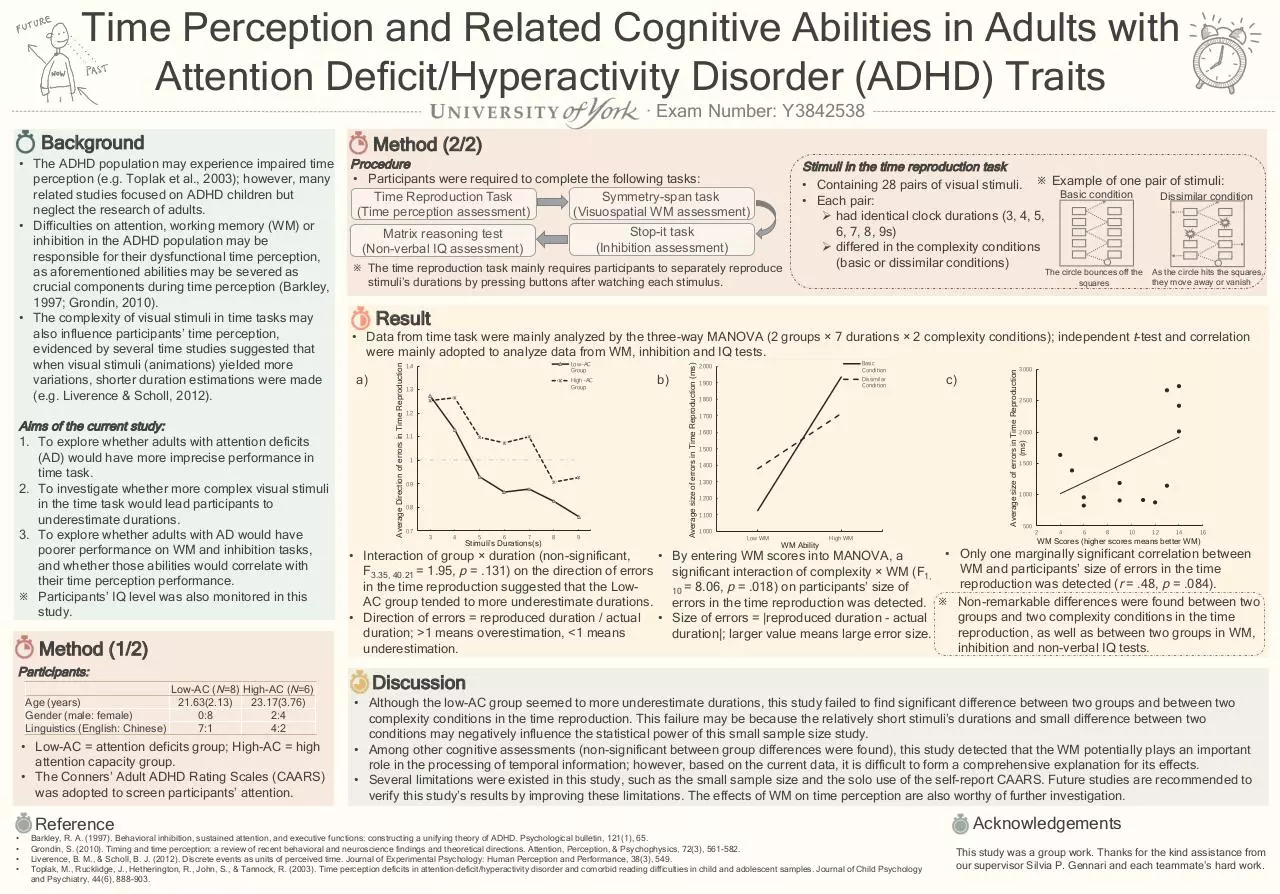Poster Time study on Adults with AD (PDF)
File information
Title: Poster_Time Reproduction and Related Cognitive Abilities in Adults with Attention Deficit:Hyperactivity Disorder Traits
This PDF 1.3 document has been generated by PowerPoint / Mac OS X 10.12.6 Quartz PDFContext, and has been sent on pdf-archive.com on 04/09/2017 at 02:27, from IP address 144.32.x.x.
The current document download page has been viewed 96 times.
File size: 281.82 KB (1 page).
Privacy: public file

File preview
Time Perception and Related Cognitive Abilities in Adults with
Attention Deficit/Hyperactivity Disorder (ADHD) Traits
· Exam Number: Y3842538
Background
Method (1/2)
Participants:
Low-AC (N=8) High-AC (N=6)
Age (years)
21.63(2.13)
23.17(3.76)
Gender (male: female)
0:8
2:4
Linguistics (English: Chinese)
7:1
4:2
• Low-AC = attention deficits group; High-AC = high
attention capacity group.
• The Conners’ Adult ADHD Rating Scales (CAARS)
was adopted to screen participants’ attention.
Reference
•
•
•
•
Matrix reasoning test
(Non-verbal IQ assessment)
Stop-it task
(Inhibition assessment)
※ The time reproduction task mainly requires participants to separately reproduce
stimuli’s durations by pressing buttons after watching each stimulus.
Stimuli in the time reproduction task
• Containing 28 pairs of visual stimuli. ※ Example of one pair of stimuli:
Basic condition
Dissimilar condition
• Each pair:
Ø had identical clock durations (3, 4, 5,
6, 7, 8, 9s)
Ø differed in the complexity conditions
(basic or dissimilar conditions)
The circle bounces off the
squares
As the circle hits the squares,
they move away or vanish
Result
a)
b)
Stimuli’s Durations(s)
c)
WM Ability
Average size of errors in Time Reproduction
(ms)
• Data from time task were mainly analyzed by the three-way MANOVA (2 groups × 7 durations × 2 complexity conditions); independent t-test and correlation
were mainly adopted to analyze data from WM, inhibition and IQ tests.
Average size of errors in Time Reproduction (ms)
Aims of the current study:
1. To explore whether adults with attention deficits
(AD) would have more imprecise performance in
time task.
2. To investigate whether more complex visual stimuli
in the time task would lead participants to
underestimate durations.
3. To explore whether adults with AD would have
poorer performance on WM and inhibition tasks,
and whether those abilities would correlate with
their time perception performance.
※ Participants’ IQ level was also monitored in this
study.
Procedure
• Participants were required to complete the following tasks:
Symmetry-span task
Time Reproduction Task
(Visuospatial WM assessment)
(Time perception assessment)
Average Direction of errors in Time Reproduction
• The ADHD population may experience impaired time
perception (e.g. Toplak et al., 2003); however, many
related studies focused on ADHD children but
neglect the research of adults.
• Difficulties on attention, working memory (WM) or
inhibition in the ADHD population may be
responsible for their dysfunctional time perception,
as aforementioned abilities may be severed as
crucial components during time perception (Barkley,
1997; Grondin, 2010).
• The complexity of visual stimuli in time tasks may
also influence participants’ time perception,
evidenced by several time studies suggested that
when visual stimuli (animations) yielded more
variations, shorter duration estimations were made
(e.g. Liverence & Scholl, 2012).
Method (2/2)
WM Scores (higher scores means better WM)
• Only one marginally significant correlation between
• Interaction of group × duration (non-significant,
• By entering WM scores into MANOVA, a
WM and participants’ size of errors in the time
F3.35, 40.21 = 1.95, p = .131) on the direction of errors significant interaction of complexity × WM (F1,
reproduction was detected (r = .48, p = .084).
in the time reproduction suggested that the Low10 = 8.06, p = .018) on participants’ size of
AC group tended to more underestimate durations. errors in the time reproduction was detected. ※ Non-remarkable differences were found between two
groups and two complexity conditions in the time
• Direction of errors = reproduced duration / actual • Size of errors = |reproduced duration - actual
reproduction, as well as between two groups in WM,
duration; >1 means overestimation, <1 means
duration|; larger value means large error size.
inhibition and non-verbal IQ tests.
underestimation.
Discussion
• Although the low-AC group seemed to more underestimate durations, this study failed to find significant difference between two groups and between two
complexity conditions in the time reproduction. This failure may be because the relatively short stimuli’s durations and small difference between two
conditions may negatively influence the statistical power of this small sample size study.
• Among other cognitive assessments (non-significant between group differences were found), this study detected that the WM potentially plays an important
role in the processing of temporal information; however, based on the current data, it is difficult to form a comprehensive explanation for its effects.
• Several limitations were existed in this study, such as the small sample size and the solo use of the self-report CAARS. Future studies are recommended to
verify this study’s results by improving these limitations. The effects of WM on time perception are also worthy of further investigation.
Barkley, R. A. (1997). Behavioral inhibition, sustained attention, and executive functions: constructing a unifying theory of ADHD. Psychological bulletin, 121(1), 65.
Grondin, S. (2010). Timing and time perception: a review of recent behavioral and neuroscience findings and theoretical directions. Attention, Perception, & Psychophysics, 72(3), 561-582.
Liverence, B. M., & Scholl, B. J. (2012). Discrete events as units of perceived time. Journal of Experimental Psychology: Human Perception and Performance, 38(3), 549.
Toplak, M., Rucklidge, J., Hetherington, R., John, S., & Tannock, R. (2003). Time perception deficits in attention-deficit/hyperactivity disorder and comorbid reading difficulties in child and adolescent samples. Journal of Child Psychology
and Psychiatry, 44(6), 888-903.
Acknowledgements
This study was a group work. Thanks for the kind assistance from
our supervisor Silvia P. Gennari and each teammate’s hard work.
Download Poster Time study on Adults with AD
Poster_Time study on Adults with AD.pdf (PDF, 281.82 KB)
Download PDF
Share this file on social networks
Link to this page
Permanent link
Use the permanent link to the download page to share your document on Facebook, Twitter, LinkedIn, or directly with a contact by e-Mail, Messenger, Whatsapp, Line..
Short link
Use the short link to share your document on Twitter or by text message (SMS)
HTML Code
Copy the following HTML code to share your document on a Website or Blog
QR Code to this page

This file has been shared publicly by a user of PDF Archive.
Document ID: 0000667982.